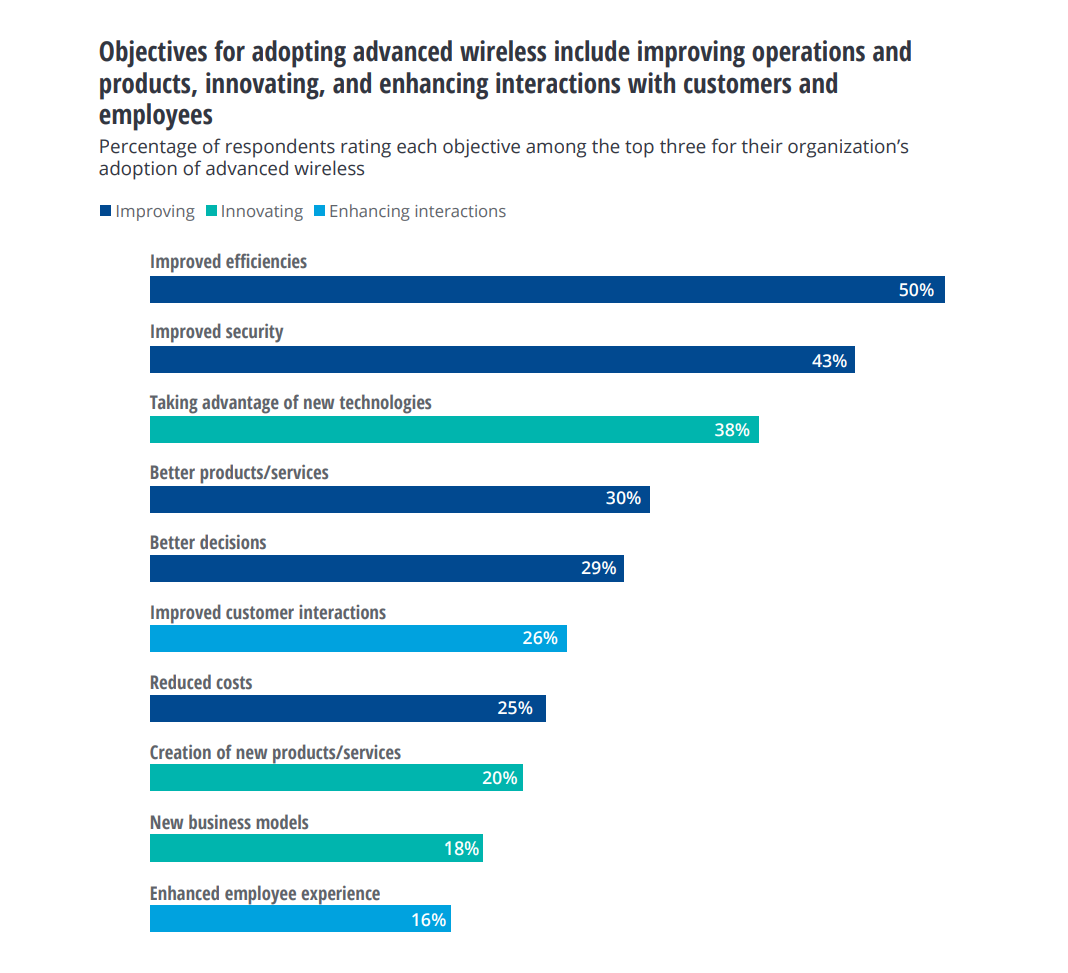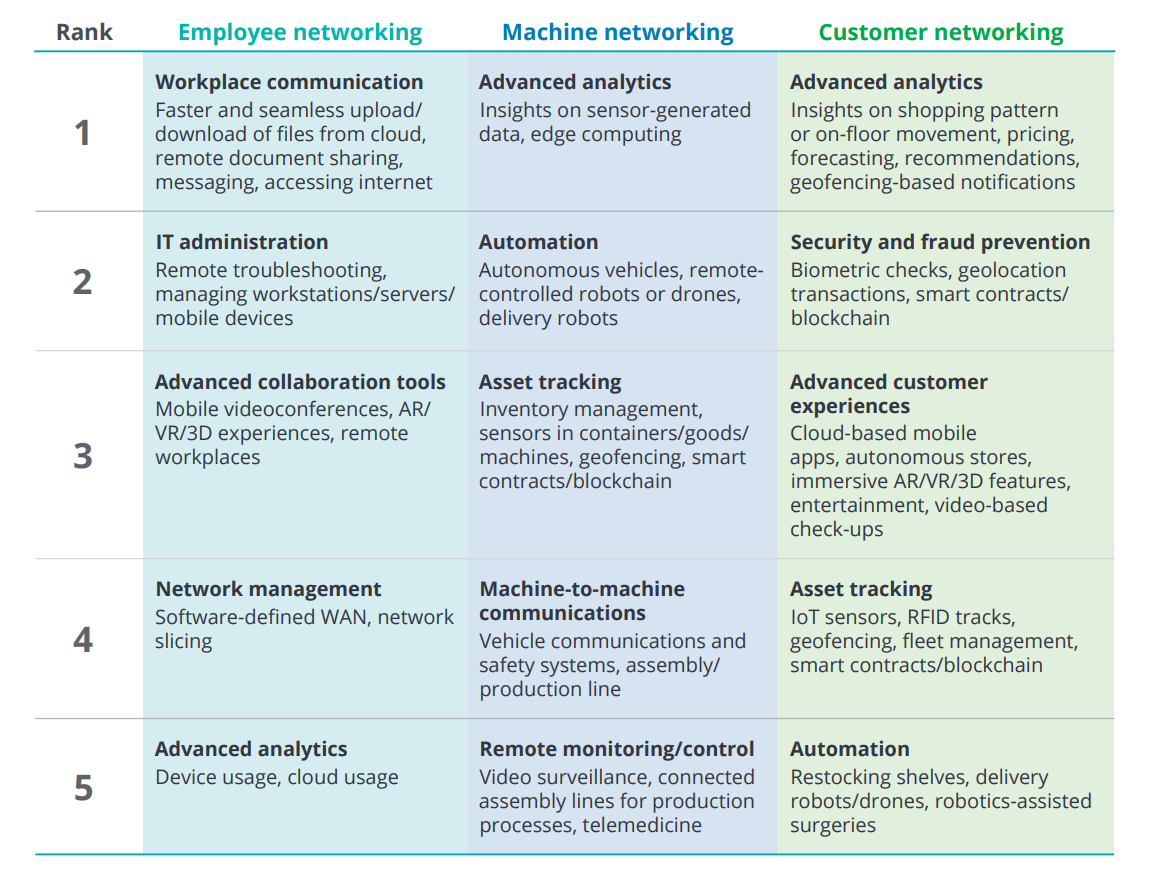The promise of 5G is much more than faster network speeds. It is a real and present opportunity for businesses to embark on digital transformation at scale. As adoption and usage increases, the benefits to both businesses and individuals is becoming clear.
“Whatever we do now with our smartphones we'll be able to do faster and better,” said Ian Fogg, VP of Analysis at OpenSignal, a mobile data analytics company.
“Think of smart glasses featuring augmented reality, mobile virtual reality, much higher quality video, the internet of things making cities smarter. But what's really exciting is all the new services that will be built that we can't foresee.”
Organizations looking to future-proof their systems and products are recognizing the potential and immediate benefits of 5G – its fast, reliable transmission capabilities are taking enterprise mobility to the next level by enabling collaboration and increasing productivity at remote locations. Let’s examine the benefits 5G brings to companies small and large, and how this network upgrade will supercharge business.
What Is 5G and How Does It Enable Business Objectives?
5G is the fifth generation of mobile wireless communication technology – the next technological upgrade to 4G. By using shorter, higher-frequency bands of the radio spectrum, 5G offers greater load capacity, faster speeds and lower latency.
While 4G brought mass video streaming, real-time media consumption, reliable payment processing, multi-player gaming, always-on social networking and other use cases that enabled new business models, 5G will revolutionize these new-age industries and transform them in ways that haven’t yet been conceptualized. Research from GSMA estimates that 5G will contribute about $565 billion to the global economy by 2034.
“You need to think about the impact and how to harness the new capabilities of speed and low latency of 5G,” said Chris Pearson, President of 5G Americas, an industry trade organization of telecommunications providers and manufacturers.
“If you don't start thinking about 5G and how it could affect or help your business, you're going to have a competitor who will.”
As data processing and mobility become central to business operations, companies of all sizes across the world are embracing 5G in different ways. IT leaders have a host of reasons to adopt 5G include improved efficiencies, reduced costs and better decisions, as per a Deloitte report.

Source: Deloitte
“Redefining the customer and employee experience is of critical importance right now for businesses of all sizes,” said Wendy Taccetta, Senior VP for Nationwide Small Business & Channel Chief at Verizon Business.
“In fact, according to research we conducted earlier this year, nearly seven in 10 business owners believe that 5G will help their company overcome the negative impact of the COVID-19 pandemic.”
The Core Advantages of 5G
Technology-wise, 5G has a number of characteristics that can power businesses by enabling better customer experiences and increasing employee productivity. Combined with other technologies such as the cloud, IoT and edge computing, 5G will change how business is done or even how entire industries operate – whether it’s finance, manufacturing, travel, retail or healthcare.
What are these characteristics?
Faster speeds:
Higher connection speed is THE benefit of 5G. While 4G theoretically tops out at 100 Mbps, 5G has the potential to reach speeds of 10 Gbps – a 100x improvement. In practical, everyday scenarios, this can translate up to 10x faster download and upload speeds at a bare minimum.
Higher device capacity:
Every network has a limit on the number of simultaneous connections – it can only handle a predefined number of devices that can transmit data concurrently.
However, businesses are increasingly using more devices, all of which are transferring more data. The 4G network just isn’t built to take this kind of load, but 5G is a different beast. Estimates suggest that 5G deployments can support a million connected devices per 0.38 square miles compared to 4G’s 2,000. This means enterprise networks can build large, complex IT infrastructures that host a virtually limitless number of devices that can undertake simultaneous data transfer (thanks to the 5G’s broader spectrum band).
Reliable connections:
The amount of data that enterprises transfer every day, every minute is growing unabated. No worries – data transfer and processing will cause far less network jams with 5G.
5G employs multi-access edge computing technology that distributes large data loads and decongests networks through localized computing. This ensures that connections are not broken or interrupted when usage spikes. What’s more 5G cells can communicate with devices that are moving (think people on a train) at speeds of 300 mph.
As a result, cloud workloads, software automation, analytics, everything runs smoother overall.
Lower latency:
Latency is the time gap between when a data packet is sent and when it is received and acknowledged. In layman’s parlance, latency is the time that passes between when you give your machine an instruction and when it does it.
High latency results in noticeable lag – something that has always been present in network connections. For example, a video streamed live (think baseball match) is always behind what is actually happening in real time on the ground. 5G does away with this limitation – it can bring down latency to less than 5 milliseconds. In comparison, 4G suffers a latency of over 60 milliseconds.
Low latency is a boon for industries and workloads where time lag has financial (think stock trading) or safety (think autonomous vehicles) implications.
Network slicing:
Network slicing is a practice that allows multiple virtual networks to be created and operated on top of a dedicated platform running on shared physical infrastructure – sort of a private network for businesses. It allows organizations to develop and deploy customized data processing methods over the LTE by running multiple services (with different functional and performance requirements) over the same underlying network architecture. They can also provision and assign resources on an as-needed basis for each application.
For perspective, consider how the Uber app performs different kinds of tasks – shows nearby drivers with ETA, connects the passenger to a driver, maps the route (with changes if needed), and processes payments, all with a few taps.
Impact and Applications of 5G in Various Industries
5G is revolutionizing existing business models by providing new avenues for innovation, productivity, connectivity and customer experience. “The benefits apply across industries, and we see early opportunity in some first-mover industries like manufacturing, transportation and logistics, and venues and hospitality,” said Masum Mir, VP and General Manager for Cisco’s Mobile, Cable and IoT business.
There are potentially unlimited scenarios where 5G enables or revolutionizes a business function, depending on who is using the technology – consumers, employees or even machines – and for what.

Source: Deloitte
Let’s see how businesses in some specific sectors are using 5G to integrate IT with operational technology (OT) systems to improve efficiency.
Manufacturing
With 5G connectivity, process automation becomes even faster. Remote-controlled simulators, drones and robots can be deployed and operated with greater precision and performance and environmental metrics can be sent back to the controller in real-time. This results in significant savings in factory infrastructure as well as enhances safety and productivity of human workers.
Healthcare
The socio-economic impact of 5G is perhaps most pronounced in healthcare. Remote, automated surgery might grab all the media hype, but when COVID was ravaging the world in the last two years, 5G gave patients and caregivers the ability to interact online (and get timely help) in many places, including rural areas. This resulted in more and faster recoveries.
With 5G, doctors based in a hospital or even at home can interact with nurses, field paramedics and other frontline health workers and diagnose the patient quickly or even provide preventive care using high-res video, patient telemetry and telehealth services. The onboarding, registration and prescription handling could be handled by associated workers concurrently with prognosis and treatment.
Field operations and professional services
Tradespeople such as plumbers and carpenters, professional service providers such as lawyers and doctors, and engineers and technicians dealing with different kinds of hardware and equipment frequently find themselves in situations where unseen and unheard of challenges crop up. Many times, the solution begs collaboration, research and additional guidance from peers or seniors. 5G-enhanced connectivity can save crucial hours or even days in such scenarios.
In future, 5G-powered VR and AR headsets and applications will give these workers real-time troubleshooting assistance and access to updated checklists and best practices, speeding up issue resolution and project completion.
Using 5G to Supercharge Business
If 5G delivers on its promises, it will likely creep into every aspect of business operations. Even when and where we work will be affected, with the possibility of remote teams empowering organizations to hire top talent outside of their local area, or even country.
However, this transformation will by no means be as simple as switching to a new network provider. Forward-thinking leaders need to capitalize on the rollout of 5G networks by laying the groundwork at the right pace for their company. Some steps to take would be:
Including 5G in the budget
Like all new technologies, 5G hardware will be more expensive than 4G hardware. For businesses to remain competitive when a full-scale launch or switch-over occurs, they’ll need 5G-ready equipment on hand and ready to go. That said, like all popular technologies, the price of 5G-ready devices and equipment will rapidly go down in line with adoption.
Intensifying big data analytics
5G will facilitate advances in AI, automation, and IoT. But with great advances comes great big data. How a company gathers, stores, and uses that data, the ways it analyzes the data and the tools it uses to do so will determine the competitive advantage it gains from the insights it collects.
Providing 5G education
Teams cannot make the most of this new technology if they don’t understand what it is and the potential it offers. Educating employees on how 5G can support business goals, improve customer experience, and drive growth is essential to bring everyone on board.
Preparing for the next wave of automation and AI
Faster speeds and lower latency lend themselves to an influx in new automation and AI technologies. Businesses will rely on mobile networks more than ever and will need to work with IT specialists to redesign and streamline core operations to integrate AI-based algorithms, software and services into business-critical applications.
Strategizing 5G use
Technology is always evolving and improving. Today’s 5G capabilities will be limited compared to those of the future and the inevitable advent of 6G a few years down the line. Companies must strategize how they are going to use 5G now, twelve months from now, and beyond.
Faster, Cheaper, Better
Whether it’s tomorrow, next year, or five years down the line, 5G will be the wireless technology of choice for companies and stakeholders to connect to each other. Autonomous vehicles, robot assistants and immersive virtual experiences will soon be mainstream.
5G creates opportunities that enable the creation of new business models, products and services around these technological advancements by providing faster and better connectivity. It is up to each business to put 5G to work in ways that expedite data analysis and provide a better brand experience to customers.
Editor’s note: This is an updated version of the article first published on September 15, 2020.
Michael Brenner wrote the original version. He is a keynote speaker, author, and CEO of Marketing Insider Group. Michael has written hundreds of articles on sites such as Forbes, Entrepreneur Magazine, and The Guardian. He speaks at dozens of leadership conferences each year covering topics such as marketing, leadership, technology, and business strategy. Follow him @BrennerMichael.
Dipti Parmar updated this article. She is a marketing consultant and contributing writer to Nutanix. She’s a columnist for major tech and business publications such as IDG’s CIO.com, Adobe’s CMO.com, Entrepreneur Mag, and Inc. Follow Dipti on Twitter @dipTparmar or connect with her on LinkedIn for little specks of gold-dust-insights.
© 2022 Nutanix, Inc. All rights reserved. For additional legal information, please go here.

